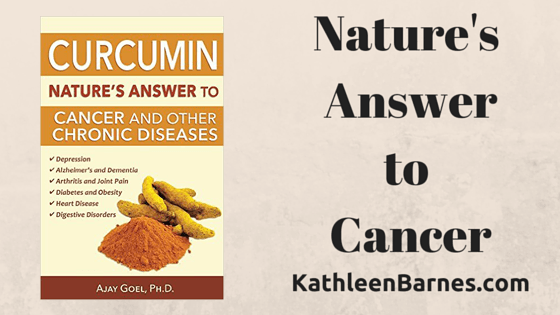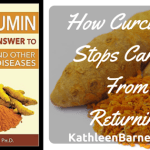Curcumin: Nature’s Answer to Cancer and Other Inflammatory Diseases by Ajay Goel, Ph.D.
Note from Kathleen: I’ve written a great deal about cancer and its relentless spread in our lives. I’ve just published an exceptional book from my friend and renowned Baylor cancer researcher Ajay Goel, Ph.D. There is much wisdom here ad some easy strategies you can take home and use now to prevent and treat cancer and other inflammatory diseases, my friends.
Why We’re Losing the War on Cancer
The U.S. declared war on cancer more than 50 years ago. We’re losing that war.
More than $100 billion has been spent on cancer research in the U.S. alone, resulting in a host of outrageously expensive and largely ineffective new drugs and implementing cutting edge diagnostic techniques. Despite this enormous expenditure, the cancer death rate, adjusted for the size and age of the population, has only decreased by 5% since 1950, according to a 2009 New York Times article.
If you have cancer, if you know anyone with cancer or if anyone you love has died of cancer, you might be feeling angry right now. Your anger would be well justified.
I’ll give you a simple answer: We’re losing the war on cancer because we did not recognize that each person’s cancer is a unique and individual disease. There is no one-size-fits-all solution. Cancer is a terribly complex disease.
What’s more, laser-targeted approaches to cancer treatment will inevitably fail because cancer cells are smart. They’re so smart that they almost seem to have a brain. As soon as we target cancer cells from one direction, they change direction and become resistant to whatever therapy worked last week or last month.
To successfully treat cancer, we must first understand the individual nature of each person’s cancer. Then we must approach that cancer from a wide variety of ways. We need to see what will work this week and anticipate what will work next week, because what will work in the future course of an individual’s disease will assuredly be different than what has worked in the past.
You already know this is a book on curcumin. There will be a lot more detail on curcumin and how it works, but ponder this as we proceed:
Curcumin is one of the only naturally occurring medicines known to science that targets cancer from so many directions at once.
I say this without qualification. Curcumin is a natural substance and it is one of the only substances, natural or synthetic, that science has proven addresses and combats cancer in so many different ways.
How does curcumin fit into this picture?
If you love curry, you’ll be familiar with turmeric, a popular vividly colored golden spice.
Turmeric in itself has a plethora of health benefits, if you’re willing to eat it in huge quantities from childhood on. Botanically known as Curcuma longa, the turmeric rhizome is a member of the antioxidant-rich ginger family.
You might be understandably skeptical when you hear that this humble Indian spice can prevent, treat and sometimes even cure a wide variety of serious diseases. These include everything from cancer, heart disease, the pain of all types of arthritis and even “incurable” diseases like diabetes and Alzheimer’s.
Curcumin has shown positive effects in treating every single disease for which it has been studied.
For centuries, this super plant has given the gift of long life and robust health to my ancestors in India, for whom various types of curries—always made with turmeric—are a dietary staple eaten several times a day.
It is also an integral part of religious traditions in the Indian Hindu culture. Its golden paste applied to the forehead is used in devotional ceremonies and weddings.
For more than 6,000 years, turmeric has been used as a medicine in one of the oldest systems of traditional medicine, Ayurveda, which seeks to bring balance to the body’s elemental substances and energy centers. Recent research shows that most of the benefits attributed to turmeric in the Ayurvedic tradition actually are attributed to curcumin. It is sometimes called “the Golden Goddess” because of its vast healing powers.
Now we get down to the 21st century practical application:
Inside turmeric is a compound called curcumin, which is found in its rhizome (the stem of the plant found underground). Curcumin is responsible for the golden orange color of turmeric, and is perhaps the most powerful naturally occurring medicine known to humankind today. In simple terms, turmeric is the spice and curcumin is the medicine.
Curcumin has shown positive effects in treating every single disease for which it has been studied.
However, there is very little curcumin in the spice turmeric. If you’ve seen cheap turmeric supplements on the market, understand that they only contain 2 to 5% curcumin, which may or may not be usable by your body. They’re not likely to have much effectiveness in terms of prevention or treatment for the diseases we’re talking about. Curcumin is many times more powerful than turmeric.
In the 21st century, curcumin’s medicinal value is backed by voluminous research that credits its healing powers to its exceptional antioxidant and anti-inflammatory properties.
Curcumin is by far one of the most powerful antioxidants known to science, hundreds of times more powerful than blueberries, which have substantial antioxidant capabilities themselves.
Curcumin literally scrubs the oxidative “rust” from your cells, preventing serious disease and reversing diseases you may already have. It helps stop cell deterioration and restores the cellular genetic codes to youthful levels, ensuring those cells will reproduce more like they did when you were young.
On the ORAC (Oxygen Radical Absorbance Capacity) scale that rates the antioxidant power of foods, the antioxidant power of the more bioavailable preparations of curcumin rate over 15,000 per 1 single gram, while antioxidant-rich blueberries have only a 600 ORAC rating per single gram! This means that just one high-quality curcumin capsule delivers more than 25 times the antioxidants as the same amount of blueberries.
We’ll learn more about the connection between inflammation and cancer in the next chapter, but let it suffice to say here that curcumin’s antioxidant superpowers result in lower levels of inflammation and lower risk of cancer and a host of other chronic diseases.
More important, from the viewpoint of damaged cell division found in cancer, curcumin also tells these cells to die when their time comes, as ordained by nature, which stops tumor growth. It also helps kill cancerous tumors by cutting off their blood supply, stops the spread of cancer and kills cancer stem cells that stay alive in your blood stream for years, preventing recurrences of old cancers. It even enhances the effectiveness of chemotherapy drugs and radiation therapy commonly used in conventional cancer treatment.







